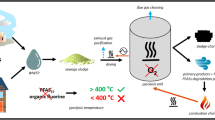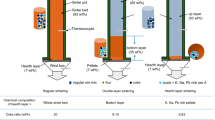Abstract
The process of bioweathering involving natural microbes, natural plants and transgenic animals has proven to be a very efficient and effective tool for detoxifying xenobiotics. The present investigation uses the same tool as a device for detoxifying asbestos, a potent carcinogenic entity. The cellular mechanism of asbestos toxicity to a certain extent, as shown by research, is attributed to its chemical composition particularly the presence of iron in its structure. Many bacteria release iron chelating compounds, siderophores, which could be instrumental in the study. Treatment of asbestos was carried out under specific parameters with bacterial isolates native to the mines of Rajasthan from which asbestos was collected. An assessment was then done to evaluate reduction in iron content of the asbestos fibres by Scanning Electron Microscopy-Energy Dispersive X-ray (SEM-EDX). A remarkable decrease was observed in the iron content of asbestos following treatment with most of the bacterial isolates used, which probably could form the basis for asbestos bioweathering studies.
Similar content being viewed by others
References
Daghino S, Martino E, Tomatis M, Fenogiio I, Perotto S, Fubini B (2005) Inorganic materials and living organisms: surface modifications and fungal responses to various asbestos forms. Chem Euro J 11:5611–5618
Toyokuni S (2009) Mechanism of asbestos induced carcinogenesis. Nagoya J Med Sci 71:1–10
Dusinska M, Collins A, Kazimirova A, Barancokova M, Harrington V (2004) Genotoxic effects of asbestos in humans. Mutation Resour 553(1-2):91–102
Daghino S, Turcim F, Tomatis M, Favier A , Perotto S, Douki T, Fubini B (2006) Soil fungi reduce the iron content and DNA damaging effects of asbestos fibres. Environ Sci Technol 40(18):5793–5798
Kubo Y, Takenaka Hiroyuki, Nagai Hirotaka, Toyokuni Shinaya (2012) Distinct affinity of nuclear proteins to the surface of chrysotile and crocidolite. J Clin Biochem Nutr 51(3):221–226
Bergamini C, Fato R, Biagini G, Pugnaloni A, Giantomassi F, Foresti E, Lesci GI, Roveri N, Lenaz G (2007) Mitochondrial changes induced by natural and synthetic asbestos fibers: Studies on isolated mitochondria. Cell Mol Bio 52:905–913
Kilburn KH (2000) Indoor air effects after building renovation and in manufactured homes. Am J Med Sci 320(4):249–54
Mapelli F, Marasco R, Balloi A, Rolli E, Cappitelli F, Daffonchio D, Borin S (2012) Mineral–microbe interactions: Biotechnological potential of bioweathering. J Biotechnol 157(4):473–481
Daghino S, Martino E, Vurro E, Tomatis M, Girlanda M, Fubini B, Perotto S (2008) Bioweathering of chrysotile by fungi isolated in ophiolitic sites. FEMS Microbiology Letters 285:242–249
Prandi L, Tomatis M, Penazzi N, Fubini B (2002) Iron cycling mechanisms and related modifications at the asbestos surface. Ann Occup Hyg 46:140–143
Martino E, Prandi L, Fenoglio I, Bonfante P, Perotto S, Fubini B (2003) Soil fungal hyphae bind and attack asbestos fibers. Angew Chem Int Ed 42:219–222
Martino E, Carminara S, Prandi L, Fubini B, Perotto S (2004) Physical and biochemical interactions of soil fungi with asbestos fibres. Environ Toxicol Chem 23:938–944
Favero-Longo S, Turci F, Tomatis M, Piervittori (2005) Chrysotile asbestos is progressively converted into a nonfibrous amorphous material by the chelating action of lichen metabolites. J Env Monit 7:764–766
Favero-Longo SE, Girlanda M, Honegger R, Fubini B, Piervittori R (2007) Interactions of sterile-cultured lichen-forming ascomycetes with asbestos fibres. Mycol Res 2007 111(Pt 4):473–81
Crawford RH, Floyd M, Li CY (2000) Degradation of serpentine and muscovite rock minerals and immobilization of cations by soil Penicillium species. Phyton Horn Austria 40(2):315–322
Faver-Longo S, Siniscalco C, Piervittori (2006) Plant and Lichen colonization in an asbestos mine: Spontaneous bioattenuation limits air dispersion of fibres. Plant Biosystems 14(92):190–205
Iman AF, Hussain Dr, Ma’an A (2011) Kinetic study of a bacterial consortium isolated from soil contaminated with crude oil. Australian J. Basic App. Sci 5(6):925–930
Zang Shu-ying, Wang Quingfeng (2011) Changes in bacterial community of authracene bioremediating, composting soil. J Zhejiang Univ Sci 12(9):760–768
Nyakundi WO, Magema G (2011) Biodegradation of diazinon and methomyl pesticide by white rot fungi. J. of App Tech Env Sanitation 1(20):107–124
Neilands JB (1995) Siderophores:-Sructure and Function of microbial iron transport compounds. J Biol Chem 270:26723–26
Chu BC, GraciaHerrero A, Johanson TH, Krewulak KD, Lau CK, Peacock RS, Slavinskaya Z, Vogel HJ (2010). Biometals 23(4):601–11
Kirchman DL (2012) Processes in Microbial Ecology: Microbial growth, biomass production and controls, 108; Oxford Univ. Press Inc., New York
Waksman SA (1927) Principles of soil microbiology, 12-13, Baltimore. Williams and Wilkins Co., London
Warcup JH (1950) The soil plate method for isolation of fungi from soil, Nature, Lord 166:117–118
Bergey’s (1974) Manual of Determinative Bacteriology (1923-57) Seven editions, lst, 1923; 2nd, 1926; 3rd, 1930; 4th, 1934; 5th, 1939; 6th, 1949; 7th, 1957; 8th. Williams and Wilkins Company, Baltimore
Lapage S, Shelton J, Mitchell T (1970). In: Norris J, Ribbons D (eds) Methods Microbiol. 3A Academic Press, London
Faddin MJ (1985) Media for Isolation-Cultivation-Identification-Maintenance of Medical Bacteria, Vol. l. Williams and Wilkins, Baltimore
Kuczumow A (2011) Estimation of asbestos release from building materials to the air in South Eastern Poland. Proceedings of 12th Int. Conf. on Env. Sc. And Tech, Rhodes, Greece
Daghino S, Turci F, Tomatis M (2009) Weathering of chrysotile asbestos by the serpentine rock inhabiting fungus Verticillium leptobactrum. FEMS Micro Eco 69:132–141
Paris F, Bonnaud P, Ranger J, Lapeyrie F (1994) Phyllosilicate alteration by ectomycorrhizal fungi in-vitro. Acta Bot Gallica 141:529–532
Calvaruso C, Turpault MP, Frey-Klett P (2006) Root-associated bacteria contribute to mineral weathering and to mineral nutrition in trees: a budgeting analysis. Appl Environ Microb 72:1258– 1266
Patel AK, Deshattiwar MK, Chaudhari B.L., Sudhir B.C (2009) Production, purification and chemical characterization of the catecholate siderophore from potent probiotic strains of Bacillus spp. Bioresource Technol 100:368–373
Haas H (2003) Molecular genetics of fungal siderophore biosynthesis and uptake: the role of siderophores in iron uptake and storage. Appl Microbiol Biol 62:316–330
Cornelis P, Matthijs S (2002) Diversity of siderophore-mediatediron uptake systems in fluorescent pseudomonads: not only pyoverdines. Environ Microbiol 4:787–798
Challis GL, Ravel J (2000) Coelichelin, a new peptide siderophore encoded by the Streptomyces coelicolor genome: structure prediction from the sequence of its non-ribosomal peptide synthetase. FEMS Microbiol Lett 187:111–114
Author information
Authors and Affiliations
Corresponding author
Rights and permissions
About this article
Cite this article
Bhattacharya, S., John, P.J. & Ledwani, L. Bacterial Weathering of Asbestos. Silicon 7, 419–431 (2015). https://doi.org/10.1007/s12633-014-9260-9
Received:
Accepted:
Published:
Issue Date:
DOI: https://doi.org/10.1007/s12633-014-9260-9




